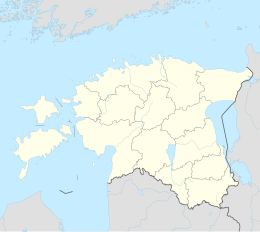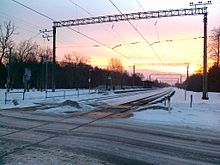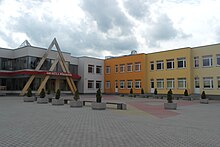Aruküla (Raasiku)
| Aruküla | ||
| State : |
|
|
| Circle : |
|
|
| Founded : | 1291 | |
| Coordinates : | 59 ° 22 ′ N , 25 ° 5 ′ E | |
| Residents : | 2,016 (2013) | |
| Time zone : | EET (UTC + 2) | |
|
|
||
Aruküla (German: Arroküll ) is a village ( Estonian alevik ) in Estonia in Harju County . It has been the main town of the Raasiku rural community ( Raasiku vald ) and the seat of the local government since 1992 .
history
The place was first mentioned in 1291 under the name Arenculle . The place belongs first three centuries of Cistercian - Padise Monastery .
During the Great Northern War in 1710 almost all residents fell victim to the plague . On the orders of the new Tsarist rulers, Russian families from Ingermanland also settled in Aruküla in 1730 . There were also Finnish settlers from the Uusimaa region .
Schools have been given in the village since 1862. Today there are two schools in the village: one is the state primary school, which teaches from the first to the ninth grade; on the other hand the Free Waldorf School .
railroad
The construction of the railway line from the Estonian capital Tallinn to the Russian capital Saint Petersburg in 1870 brought an upswing. The influential landlord of Aruküla, the Baranoff family (noble family) had a need stop built. He was called Baranovka . The settlement grew particularly at the beginning of the 20th century. Today's Aruküla station on the important railway line between Tallinn and Tapa was built in the 1920s. In the 1920s, a simple wooden station building was erected. It was demolished in 2000. Today Aruküla only has two low platforms with the two train tracks. They are each 150 meters long.
The stop is now served by the Estonian railway companies Elektriraudtee and Edelaraudtee . The line is electrified. Express trains do not stop in Aruküla.
Good from Aruküla
Aruküla estate was founded in 1560. At the beginning of the 17th century it was donated to the brothers Johan and Jakob De la Gardie through a will, and then to the Swedish military officer Lennart Torstensson , Johan's son-in-law. It split from the Raasiku estate in 1726 . From November 1766 the estate was owned by the noble Baranoff family . It remained in their possession until it was expropriated as part of the land reform in 1919.
In the 1820s, the manor's single storey mansion was completed. It was designed by the Tallinn architect C. Starck. The stone building is in the classicism style. It was heavily redesigned at the turn of the 19th and 20th centuries and a second floor made of wood was added to its central section. Some of the outbuildings and the park in the English style have also been preserved .
With the Estonian land reform in 1919, the Estonian state also expropriated the estate of Aruküla. Because of his services in the War of Independence against Soviet Russia , he gave it, together with the surrounding fields and forests, to the politician Karl August Einzund (1888–1942). Integration (from 1935 onwards Kaarel Eenpalu ) was later multiple Estonian interior minister, president of the Riigikogu and in 1932 and 1938/39 Estonian head of government. He ran the Hellema talu farm in Aruküla .
20th century
Incorporation donated the manor house to the Aruküla school in 1921. In 1978 a new school building was built. Today the local Waldorf School is located in the manor house .
In 1926 the first plans to build a garden city in the pine forest of Aruküla were made. Due to legal difficulties, however, the plans dragged on. Because of the Second World War , they could only be implemented in the 1950s. Aruküla's cultural center was completed in 1939. The very dilapidated wooden building was demolished in autumn 2006.
After the Soviet occupation of Estonia, two kolkhozes were founded in the place : "The Victory of October" ( Oktoobri võit ) and "The Soviet Peasant" ( Nõukogude Põllumees ). In 1974 the collective farm administration moved into its new building. Today it houses the administration of the Raasiku rural community.
In 1957 the singer's stage was inaugurated in a pine forest. In the immediate vicinity there is a large boulder , the so-called Hellamaa kivi . It has a circumference of 32.2 m and a height of 6.2 m.
Sons and daughters of the place
The Russian-Estonian painter Andrei Jegorov (1878–1954) and the politician Jaanus Rahumägi (* 1963) come from Aruküla .
The place became the home of the writer Veera Saar (1912-2004), the musicians Juhan Trump (* 1964), Kristo Matson (* 1980) and Raul Sepper (* 1951) and the former top athlete Heino Puuste (* 1955).
Web links
- Gut von Aruküla (Estonian)
- Description of the place (Estonian)
Individual evidence
- ↑ http://www.eha.ee/kinnistud/kinnistud.php?module=65&op=3&kid=16714 ( page no longer available , search in web archives ) Info: The link was automatically marked as defective. Please check the link according to the instructions and then remove this notice.
- ↑ http://www.eestigiid.ee/?SCat=15&CatID=0&ItemID=116






